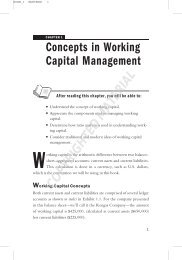ISSUE 5 2008 - Sweet & Maxwell
ISSUE 5 2008 - Sweet & Maxwell
ISSUE 5 2008 - Sweet & Maxwell
Create successful ePaper yourself
Turn your PDF publications into a flip-book with our unique Google optimized e-Paper software.
410 Global Digest [<strong>2008</strong>]<br />
necessary for the trial judge in her summing-up to have denied the implication that<br />
the parts of the video recording that they had seen was evidence of the appellant’s<br />
emotional state. In order to distance the evidence from the purpose suggested by<br />
the prosecution, a suitably framed direction was required.<br />
There was a distinction to be drawn between a direction and a comment. This<br />
reflected the fundamental division of functions in a criminal trial between judge and<br />
jury. Telling a jury that they may attach particular significance to a fact or suggesting<br />
that evidence may be considered of greater weight, is comment. Comment may<br />
properly be ignored by a jury. A direction will contain warnings about either the<br />
degree of care needed in assessing some evidence, or the use to which it may be<br />
put. A direction is something that the law requires the judge to issue and the jury<br />
to heed.<br />
In the present case the judge’s statements were no more than comment. The<br />
evidence available to the jury was only part of the video recording and it was<br />
necessary for the jury to be directed in unequivocal terms that they could not safely<br />
draw the inference that the prosecutor had invited them to draw, and that they<br />
should ignore the remarks. The trial judge’s statements were directed to the reasons<br />
why they might give the evidence lesser weight that other more contemporaneous<br />
evidence. However, they failed to deny its evidentiary effect and the misdirection<br />
amounted to an error of law.<br />
Criminal Liability of Drivers who Fall Asleep Causing Death—Australia<br />
Tasmania Law Reform Institute, Issues Paper No.12: Criminal Liability of Drivers<br />
Who Fall Asleep Causing Motor Vehicle Crashes Resulting in Death or Other Serious<br />
Injury (Jiminez: 2007)<br />
Causing death by dangerous driving; Criminal liability; Fitness to drive;<br />
Tasmania<br />
The Tasmania Law Reform Institute has published an issues paper dealing with the<br />
criminal liability of drivers who cause death and serious injury as a result of falling<br />
asleep at the wheel. The paper considers the implications and practical difficulties<br />
caused by the decision of the High Court of Australia in Jiminez v The Queen (1992)<br />
173 C.L.R. 572. In that case it was held that the actions of a sleeping driver were<br />
not conscious or voluntary, which meant that he or she could not be criminally<br />
responsible for driving the car in a dangerous manner. Where a driver has fallen<br />
asleep the focus of the inquiry to determine criminal liability is, therefore, on the<br />
driving which preceded the moment when the driver fell asleep. The prosecution<br />
is required to prove that the driver was ‘‘affected by tiredness to an extent that, in<br />
the circumstances, his driving was objectively dangerous’’.<br />
The Institute notes the perception that the decision in Jiminez has made it more<br />
difficult to secure convictions where drivers have fallen asleep. Among the options<br />
for reform of the relevant Tasmanian legislation is the introduction of a legislative<br />
provision reflecting Jiminez. This would specify that if there is an appreciable risk<br />
of falling asleep, driving while sleepy may constitute negligence or dangerousness<br />
in circumstances in which the driver falls asleep and causes death or grievous<br />
© SWEET &MAXWELL






